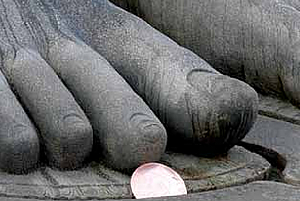
Centre of Jaina Studies Newsletter: SOAS - University of London
In March, the 2014 annual meeting of the Association of Asian Studies included a well-attended panel on the popular genre of praise-poetry known as the stotra. The papers for this panel, entitled "Beyond Conventions: Sanskrit Praise Poetry and Its Multiple Audiences," analyzed the literary practices and audiences of such works. Collectively, they sought to challenge scholars of South Asia from a variety of disciplines to rethink the inner workings of pre-modern literature and its complex roles within different communities.
In his paper, "In Praise of the Jina: The Digambara Five Stotras," John E. Cort (Denison University) introduced and analyzed the popular set of Sanskrit stotras known as the pañcastotra. He focused primarily on the Ekībhāva Stotra by the eleventh-century monk Vādirāja and the Bhaktāmara Stotra by the sixth-century monk Mānatuṅga. Cort used these stotras as a starting point for two broad arguments about the study of Jainism.
First, Cort argued persuasively that Jaina stotras, and the Five Stotras in particular, reflect a distinctively Jain expression of bhakti. Rather than being a secondary support on the path to liberation, this bhakti itself leads to liberation in the eyes of these Jain hymnists, or what we might call, at Cort's suggestion, liturgical theologians. Thus Vādirāja, in the very first verse of his hymn, states that bhakti is an efficient means for removing the bondage of karma. Mānatuṅga's Bhaktāmara Stotra also attests to the power of bhakti to transform the devotee's karmic condition. For these poets, singing such hymns enables one to overcome both physical and spiritual suffering. Through their stotras, Cort argued, they provide a charter for Jain bhakti. This bhakti and the singing of such hymns are as efficacious and central to Jainism as the ascetic and meditative practices frequently highlighted in extant scholarship. Cort's paper also challenged the common tendency within scholarship on South Asian to identify bhakti with poetry in vernacular languages.
In his second main argument, Cort emphasized that some of these devotional hymns also function as tantric texts. Their verses have been understood as mantras literally, "made of mantras" (mantramaya), and this means that their efficacy is not based on their semantic meaning or theological significance. Instead, their truly transformative power lies in the language of the hymns themselves and is, therefore, untranslatable. Cort argued that this understanding of some stotras remains operative today in the preference for the original Sanskrit text of the Bhaktāmara Stotra, for example, despite its dozens of translations into vernacular languages, for only the original language has the full ritual efficacy. In addition, Cort provided examples of how the Bhaktāmara Stotra has been treated as a set of mantras in tantric ritual. It has been the basis of complex, collective rituals, known in Digambar ritual culture as vidhāns, that utilize special maṇḍalas, yantras, and mantras as the hymn is recited by a congregation led by a religious specialist. In this way, Cort highlighted two ways that the reception and ritual use of the Bhaktāmara Stotra reflect the overlapping roles of bhakti and tantra within Jainism. As he argued in his conclusion, these two streamsesoteric tantric ritualism and exoteric bhaktiare not as distinct, and certainly not as antithetical, as some scholars have assumed.

Siddhacakra Yantra at the foot of Bahubali, Sravana Belgola, December 2013
In "Praising the Jina as Śiva: Doxographical Logic in Jain Stotra," Sarah Pierce Taylor (University of Pennsylvania) focused on how the ninth-century Jain author Jinasena engages other religious communities, and specifically Śaivas, in his Pārśvābhyudaya and Ādipurāṇa. She identified four distinct literary modes that Jinasena uses to address these communities: conversion, humor, intellectual mastery, and theological incorporation. Her analysis of the Pārśvābhyudaya illustrated how this text uses the literary strategies of conversion and humor to address rival Śaivas. Interestingly, in addition to describing straightforward conversions in the narrative, Taylor also argued that as Jinasena incorporates lines of Kālidāsa's Meghadūta into his text, he converts the familiar landscape traveled in this messenger poem into a distinctly Jain landscape. In doing so, Jinasena also uses biting humor, reducing the Śaivas to farcical characters in his representation.
For examples of intellectual mastery and theological incorporation as literary strategies, Taylor turns to Jinasena's Ādipurāṇa. Chapter five of this major work, for instance, includes the staging of a philosophical disputation in the court of the first Jina Ādinātha, incarnate here as a king, in which the Jain position unsurprisingly emerges victorious. The Ādipurāṇa, a diverse and ambitious text, also includes multiple stotras that complement the other literary strategies discussed thus far. Both the philosophical debates and the stotras in the Ādipurāṇa catalogue, incorporate, and reinterpret Śaiva vocabulary and mythology. Taylor analyzed specific verses from Jinasena's stotras to argue that this author praises the Jina as Śiva, but also as superseding Śiva through specifically Jain forms and practices. Thus the text polemically presents Jainism as both accounting for and exceeding the religious capabilities of Śaivism. She characterized the logic of these strategies as doxographical. They assimilate Śiva and the Hindu pantheon within a Jain religious worldview. Within this hierarchical framework, Jinasena's stotra in the Ādipurāṇa becomes a means of expressing the power of the Jina through the names, mythology and imagery of Śiva.
Taylor also used these examples to offer a critique of the historical periodization of Kannada literary history into three distinct phases, namely the Jain, Vīraśaiva, and Vaiṣṇava. In general, the scarcity of archival sources for pre-twelfth-century Karnataka has made it difficult to challenge the simplistic account of this period. But as Taylor demonstrated, Jinasena's ninth-century works provide evidence for a dynamic, diverse religious landscape that is a far cry from the homogeneity implied by labeling this as exclusively the Jain period. Jinasena's works, and his stotras in particular, reflect intimate knowledge and complex engagement with competing religious communities during this important period.
The present author, Hamsa Stainton (University of Kansas), analyzed a creative and ambitious collection of fourteenth-century Śaiva stotras from Kashmir called the Stutikusumāñjali in his paper, "Poetry as Prasāda: Sanskrit Stotras and the Nature of Bhakti." While he focused on Śaivism, rather than Jainism, Stainton emphasized interpretive issues relevant to the study of the stotra genre across traditions. He argued for a specific heuristic strategy for interpreting the poetic language and religious functions of Sanskrit stotras: these praisepoems can be interpreted as verbal offerings to a deity, analogous to flowers, fruits, and other such offerings. Just as these physical items are offered to a deity and then enjoyed by a community of devotees as prasāda, as a physical expression of the deity's favor or grace, these Sanskrit hymns are enjoyed by their secondary, human audiences. He argued that this interpretation is useful for an analysis of the logic of bhakti in some Sanskrit poetry. For many stotra authors, at least in Kashmir, bhakti means a form of devotional sharing and participation that is markedly aesthetic. Such hymns indicate the importance of considering the aesthetic dimensions of bhakti poetry and the communal participation envisioned in their consumption.
The benefits of this strategy for interpreting stotras, according to Stainton, are multifold. It opens up new ways of thinking about religious poetry, such as how beauty may be crucial to some verbal offerings not only because it pleases the deity but also because it allows that poetry to be appreciated and savored by a particular human audience. Like material prasāda, bhakti poetry circulates and creates community through its consumption. Jagaddhara, the author of the Stutikusumāñjali, praises and seeks to cultivate an audience of Śaiva devotees who are also aesthetic connoisseurs, able to appreciate complex theology precisely because of their ability to savor complex poetry. This approach also contributes to the literature on prasāda itself, for as Stainton argued it highlights the relationship between material and nonmaterial forms of prasāda. Finally, Stainton argued that the study of bhakti in South Asia, particularly in the second millennium CE, has not given sufficient attention to Sanskrit sources, and stotras in particular. Stotras remained a vital medium for preservation and innovation.
Each of the papers in this panel highlighted the flexibility and potential of the stotra form, and they used specific stotras to challenge and rethink broad trends in the study of Jainism and other religious traditions across South Asia. Rather than shying away from the historical complexity and vastness of the corpus of Sanskrit praise poetry, they sought to develop new tools for analyzing these versatile compositions that may prove useful for other scholars as well.
This panel was co-organized by Stainton and Audrey Truschke (Stanford University). Truschke had originally been scheduled to present a paper entitled "Commemorating Kavīndrācārya's Negotiations with Shah Jahan" but was unable to attend.
Hamsa Stainton is an Assistant Professor in the Religious Studies Department at the University of Kansas. His research interests include Sanskrit stotra literature, bhakti traditions, Śaivism, and the religious history of Kashmir.
 Hamsa Stainton
Hamsa Stainton